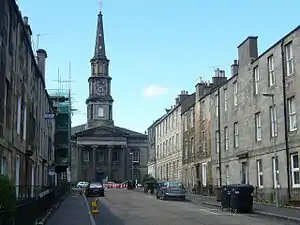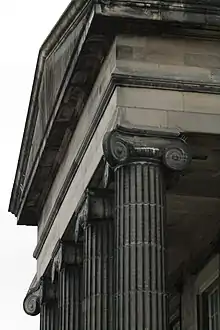North Leith Parish Church
North Leith Parish Church is a congregation of the Church of Scotland, within the Presbytery of Edinburgh. It is serves part of Leith, formerly an independent burgh and since 1920 a part of the city of Edinburgh, Scotland.

Building

The current building in Madeira Street (at the junction with Prince Regent Street), Leith, was designed by the architect William Burn and was completed in 1816. It has a notable neo-classical portico (with four large Ionic columns), above which is a clock tower surmounted by a slender spire. A pipe organ (by Wadsworth of Manchester) was added in 1880. The building was damaged by bombing during World War II (in 1941), but was repaired by 1950. It is a category A listed building.[1] The church was designed to accommodate 1300 people.[2]
William Burn was also responsible for several other notable buildings in Edinburgh, including the Edinburgh Academy and John Watson's College (now the Scottish National Gallery of Modern Art).
The associated manse (presumably also by Burn) and known as "Leith Mount", stood on a substantial plot to the south-east of the church, on Ferry Road. The manse and its gardens and orchards were removed in 1920 to provide the site for Leith Theatre.[3]
History

The church connection dates to 1128, when King David I of Scotland granted lands for the construction of Holyrood Abbey. In 1493 Robert Bellenden, Abbot of Holyrood, built St Ninian's Chapel on the north-west bank of the Water of Leith, on lands owned by the Abbey.[4] The small chapel was subsequently rebuilt after the Reformation. The replacement church opened in 1586, and later became the parish church of North Leith, which was created a quoad omnia parish, i.e. a civil and sacred parish, by a resolution of the Parliament of Scotland in 1606. A Dutch-style tower was added in 1675. The discovery of rot in this building in the 18th century led to extensive renovation and the construction of galleries within the building, but the church remained too small for the congregation, leading to its replacement by the current building in 1816 (then in fields just outside the built-up part of Leith). The Dutch-style tower of the old church still stands, although it was later incorporated into a mill.[4] In the old churchyard of St.Ninians stands the altar tomb of Thomas Gladstones (1732 - 1809), a prosperous Leith merchant, and the grandfather of the famous Prime Minister William Ewart Gladstone. Thomas Gladstones was a church elder for the 'Hill' district of Leith for over 40 years.[5]
At the point of the Disruption of 1843 North Leith parish was "vacant" (having no fixed minister) which seemed an encouragement to many to leave. North Leith Free Church was built on the corner of Coburg Street and North Junction Street, east of the church. 600 members of the congregation left, together with all the elders. The first minister was Rev William MacKenzie. The church could hold 1000 people. In 1857 Rev Robert MacDonald replaced MacKenzie. He organised the building of a magnificent new free church on Ferry Road, south of the original church. This was completed in 1859 and could hold 1100 people. The 1844 site was redeveloped as tenements. The 1859 church was demolished in 1981. A datestone was salvaged and re-used in the current church halls. North Leith Free Church no longer exists in any form. Rev Robert MacDonald served as Moderator of the General Assembly for the Free Church in 1882.[6]
North Leith Parish Church united with Bonnington Church in 1968, creating Leith North & Bonnington Church (using the Madeira Street building). In 1982, Leith North & Bonnington Church further united with Leith St Ninian's Ferry Road Church, creating the current congregation with the historic name North Leith Parish Church.
Parish
The parish largely consists of the north-west part of Leith, including the Fort housing scheme, Leith Docks, including the Ocean Terminal shopping centre, the Royal Yacht Britannia and the Scottish Government offices at Victoria Quay.
Ministry
A greatly loved cleric, Dr. David Johnston, was minister of St.Ninians from 1765 until 1824, some 59 years.[7][8] Dr. Johnston was succeeded by his long-time assistant, The Rev. Dr. Walter Foggo Ireland, who died four years later in 1828.[9] Both ministers are buried in the old churchyard of St.Ninians.[9]
Recent former ministers include:[10]
- Reverend Douglas Clarke (1968–1979) - originally inducted to Leith Bonnington Church in 1965, becoming minister of the united Leith North & Bonnington Church in 1968
- Reverend William G. Neill (1980–1986) - originally inducted to Leith North & Bonnington in 1980, moving to St Andrew's Church, Ayr, in 1986
- Reverend Alastair G. C. McGregor QC BD (1987–2002)
- Reverend Dr Kenneth S. Baird (2003–2009).[11]
- Reverend David H. Logan was minister at St Ninian's Ferry Road Church from 1965 until his retirement in 1982, at which point the congregation united with Leith North & Bonnington.
- Reverend Alexander McAspurren (2011-2019), who was previously minister of one of the two Church of Scotland congregations in Corby, Northamptonshire.,[11] demitted his charge in early 2019 to become minister of the linked parishes of Craigmillar Park Church and Reid Memorial, Edinburgh.
References
- Historic Environment Scotland. "51 Madeira Street, North Leith Parish Church with Burial Enclosure, Hall and Beadle's House, (1a Madeira Place) Gates, Railings and Boundary Wall; EH6 4AX (Category A Listed Building) (LB27134)". Retrieved 18 March 2019.
- 1854 OS map
- OS maps 1845 to 1945
- Historic Environment Scotland. "3-9 Quayside Street, Quayside Mills (Mcgregor & Co) incorporating former Manse, remains of St Ninian's Church, Tenement, Granary and Mill; EH6 6EJ (Category A Listed Building) (LB27395)". Retrieved 18 March 2019.
- Russell, John, The Story of Leith, Edinburgh, 1922, p.177.
- Ewing, William Annals of the Free Church
- Russell, p.177.
- David H. Robertson (1851). "The Sculptured Stones of Leith: With Historical and Antiquarian Notices". Leith (Edinburgh), Scotland: Reid & Son. Retrieved 28 April 2018.
- Charles Rogerss (1871). "Monuments and monumental inscriptions in Scotland, Volume 3". 1871. Grampian Club. p. 123. Missing or empty
|url=(help) - Fasti Ecclesiæ Scoticanæ (volume XI), T & T Clark, Edinburgh, 2000, page 11. ISBN 0-567-08750-6
- Church of Scotland Yearbook 2010-2011 edition, ISBN 978-0-86153-610-8
- Russell, John (1922). "XIV. Our Parish Churches: North Leith". The Story of Leith. Edinburgh: Thomas Nelson & Sons.